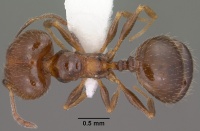Pheidole ceres
| Pheidole ceres | |
|---|---|

| |
| Scientific classification | |
| Kingdom: | Animalia |
| Phylum: | Arthropoda |
| Class: | Insecta |
| Order: | Hymenoptera |
| Family: | Formicidae |
| Subfamily: | Myrmicinae |
| Tribe: | Attini |
| Genus: | Pheidole |
| Species: | P. ceres |
| Binomial name | |
| Pheidole ceres Wheeler, W.M., 1904 | |
| Synonyms | |
| |
According to Stefan Cover, ceres is found at higher elevations and in colder climates than any other Pheidole species in the western North American fauna. In southern Arizona it is often the only Pheidole occurring above 2250 m. Gregg (1963) reports ceres to be the most abundant Pheidole in Colorado, where it occurs in a wide array of habitats, including ponderosa pine forest, foothills meadowland, and sagebrush. Cover found the species in the same general habitats in Arizona and New Mexico. In Nevada G. C. and J. Wheeler (1986) found a colony at 2650 m in juniper-pinyon woodland. The ants collect and store seeds of a variety of grasses and herbaceous angiosperms. P. ceres nests in several types of open soil under rocks. Colonies are large and active, consisting of up to 1000 ants. Majors are numerous and most colonies are monogynous. P. ceres is also notable as the host of the workerles parasite Pheidole elecebra. Winged sexuals have been found in nests principally from early to the middle of July, with one record of males on 9 September. Winged reproductives have been found in nests throughout July, and a wingless queen was collected on 21 July, presumably following a nuptial flight. (Wilson 2003)
Identification
Mackay and Mackay (2002) - This is a small species (majors < 2.5 mm total length). Most of the head is striate, only the posterior part of the head and the tops of the posterior lateral lobes are shining. The mesosoma is predominantly punctate, the side and top of the pronotum are smooth and shining. The lateral connules of the postpetiole are weakly formed, but present. The dorsal surface of the gaster is smooth and glossy. The scapes extend about half of the length of the head. The scapes of the minor worker extend about one funicular segment past the posterior lateral corners, the dorsum of the head is nearly completely glossy, the side as well as the top of the pronotum are smooth and glossy, much of the remainder of the mesosoma is densely, and coarsely punctate. The major and minor are generally dark brown. The sculpture of the dorsum of the head of the major worker generally separates it from all other species. It could be confused with Pheidole marcidula, but can be separated, as the minors do not have clavate hairs on the dorsum of the mesosoma.
Also see the description in the nomenclature section.
Keys including this Species
Distribution
Foothills of the Rockies in eastern Colorado at 1800–2600 m, southwest to the mountains of New Mexico and Arizona, at 2200–2700 m, as well as extreme eastern Nevada. Also recorded from the Davis Mts. of Texas but evidently rare there (Creighton 1950: 174), and from Guerrereo Mills, in the mountains of Hidalgo (tepaneca types). (Wilson 2003)
Latitudinal Distribution Pattern
Latitudinal Range: 40.88° to 18.494005°.
| North Temperate |
North Subtropical |
Tropical | South Subtropical |
South Temperate |
- Source: AntMaps
Distribution based on Regional Taxon Lists
Nearctic Region: United States (type locality).
Neotropical Region: Mexico.
Distribution based on AntMaps
Distribution based on AntWeb specimens
Check data from AntWeb
Countries Occupied
| Number of countries occupied by this species based on AntWiki Regional Taxon Lists. In general, fewer countries occupied indicates a narrower range, while more countries indicates a more widespread species. |

|
Habitat
Mackay and Mackay (2002) - Ponderosa pine, ponderosa pine-riparian, Gamble oak, highly disturbed areas, including burned areas, between 1500 - 2,800 meters. It is also found in pinyon-juniper and sagebrush communities in northern New Mexico, often on south-facing slopes.
Biology
Flight Period
| X | |||||||||||
| Jan | Feb | Mar | Apr | May | Jun | Jul | Aug | Sep | Oct | Nov | Dec |
Source: Wilson, 2003.
- Check details at Worldwide Ant Nuptial Flights Data, AntNupTracker and AntKeeping.
 Explore: Show all Flight Month data or Search these data. See also a list of all data tables or learn how data is managed.
Explore: Show all Flight Month data or Search these data. See also a list of all data tables or learn how data is managed.
Association with Other Organisms
 Explore: Show all Associate data or Search these data. See also a list of all data tables or learn how data is managed.
Explore: Show all Associate data or Search these data. See also a list of all data tables or learn how data is managed.
- This species is a host for the ant Pheidole elecebra (a workerless inquiline).
- This species is a host for the eucharitid wasp Orasema wheeleri (a parasite) (Wheeler, 1907; Gahan, 1940; Baker et al., 2019; Universal Chalcidoidea Database) (primary host).
- This species is a associate (details unknown) for the encyrtid wasp Pheidoloxenus wheeleri (a associate (details unknown)) (Quevillon, 2018).
- This species is a host for the pteromalid wasp Pheidoloxenus wheeleri (a parasitoid) (Quevillon, 2018) (encounter mode unknown; direct transmission; transmission outside nest).
Castes
Minor Worker
  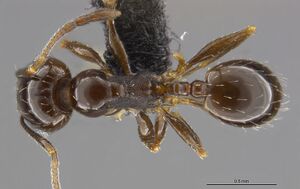 
| |
| Worker (minor). . | Owned by Museum of Comparative Zoology. |
   
| |
| Worker (minor). . | Owned by Museum of Comparative Zoology. |
Images from AntWeb
   
| |
| Worker (minor). Specimen code casent0102871. Photographer Jen Fogarty, uploaded by California Academy of Sciences. | Owned by CAS, San Francisco, CA, USA. |
 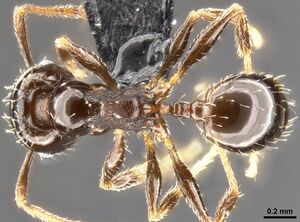   
| |
| Worker (minor). Specimen code casent0282701. Photographer Adam Lazarus, uploaded by California Academy of Sciences. | Owned by EPEC. |
Major Worker
   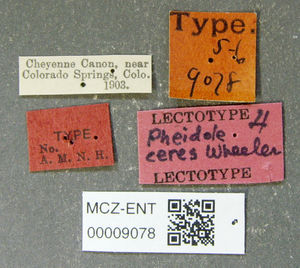
| |
| Lectotype of Pheidole ceres. Worker (major). . | Owned by Museum of Comparative Zoology. |
   
| |
| Worker (major). . | Owned by Museum of Comparative Zoology. |
   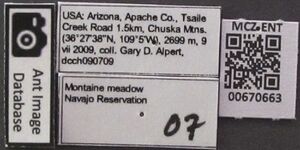
| |
| Worker (major). . | Owned by Museum of Comparative Zoology. |
Images from AntWeb
 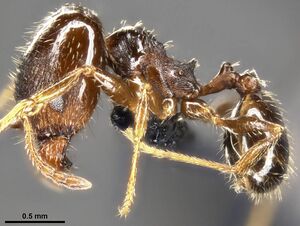  
| |
| Worker (major/soldier). Specimen code casent0282838. Photographer Adam Lazarus, uploaded by California Academy of Sciences. | Owned by EPEC. |
   
| |
| Worker (major/soldier). Specimen code casent0102870. Photographer Jen Fogarty, uploaded by California Academy of Sciences. | Owned by CAS, San Francisco, CA, USA. |
Nomenclature
The following information is derived from Barry Bolton's Online Catalogue of the Ants of the World.
- ceres. Pheidole ceres Wheeler, W.M. 1904a: 10 (s.w.q.m.) U.S.A. Senior synonym of tepaneca: Wilson, 2003: 570.
- tepaneca. Pheidole ceres subsp. tepaneca Wheeler, W.M. 1914b: 46 (s.w.q.) MEXICO. Junior synonym of ceres: Wilson, 2003: 570.
Unless otherwise noted the text for the remainder of this section is reported from the publication that includes the original description.
Description
From Wilson (2003): DIAGNOSIS A member of the “bicarinata complex” of the larger pilifera group, comprising Pheidole agricola, Pheidole aurea, Pheidole barbata, Pheidole bicarinata, Pheidole centeotl, Pheidole cerebrosior, Pheidole ceres, Pheidole defecta, Pheidole gilvescens, Pheidole macclendoni, Pheidole macrops, Pheidole marcidula, Pheidole paiute, Pheidole pinealis, Pheidole psammophila, Pheidole xerophila, Pheidole yaqui and Pheidole yucatana which complex is characterized by the large to very large, forward-set eyes, especially in the minor; and in the major, the occipital lobes lacking any sculpturing (except in aurea); the posterior half of the head capsule almost entirely smooth and shiny; and the postpetiolar node seen from above oval, elliptical, or laterally angulate (cornulate in cerebrosior).
P. ceres is distinguished within the complex by the following combination of traits. Dark to blackish brown.
Major: carinulae originating on the frontal triangle travel along the midline to the occiput; transverse carinulae present along the anterior lateral margins of the pronotum; mesonotal convexity and propodeal spines well-developed; postpetiole from above laterally angulate and diamond-shaped.
Minor: eyes moderately large; mesonotal convexity low but well-developed.
MEASUREMENTS (mm) Lectotype major: HW 1.14, HL 1.18, SL 0.66, EL 0.16, PW 0.54. Paralectotype minor: HW 0.54, HL 0.60, SL 0.54, EL 0.12, PW 0.34.
COLOR Major: body blackish brown, with brownish yellow clypeus; appendages brownish yellow to medium brown.
Minor: like the major, except that the clypeus is not yellow but dark brown and hence not contrasting.
Figure. Upper: lectotype, major. Lower: paralectotype, minor. Scale bars = 1 mm.
Type Material
COLORADO: Colorado Springs, col. W. M. Wheeler, Museum of Comparative Zoology - as reported in Wilson (2003)
Etymology
L Ceres, the pre-Roman goddess of agriculture, evidently in reference to the seed-harvesting practiced by the species. (Wilson 2003)
References
- Wilson, E. O. 2003. Pheidole in the New World: A dominant, hyperdiverse ant genus. Harvard University Press, Cambridge, MA. (page 570, fig. major, minor described, Senior synonym of tepaneca)
- Baker, A.J., Heraty, J.M., Mottern, J., Hang, J.Z., Hines, H.M., Lemmon, A.R., Lemmon, E.M. 2019. Inverse dispersal patterns in a group of ant parasitoids (Hymenoptera: Eucharitidae: Oraseminae) and their ant hosts. Systematic Entomology 45: 1–19 (doi:10.1111/syen.12371).
- Creighton, W. S. 1950. The ants of North America. Bulletin of the Museum of Comparative Zoology 104: 1–585.
- Gregg, R. E. 1963. The Ants of Colorado, With Reference to their Ecology, Taxonomy, and Geographic Distribution. Boulder: U. of Colorado Press, xvi + 792 pp.
- Mackay, W. P. and E. Mackay. 2002. The ants of New Mexico (Hymenoptera: Formicidae). Edwin Mellen Press, Lewiston, NY.
- Vázquez-Franco, C.M., Morrone, J.J. 2022. The genus Pheidole (Hymenoptera: Formicidae: Myrmicinae) in Puebla, Mexico. Revista Mexicana de Biodiversidad 93: e933820 (doi:10.22201/ib.20078706e.2022.93.3820).
- Wheeler, G. C. and J. Wheeler. 1986. The Ants of Nevada. Los Angeles: Natural History Museum of Los Angeles County, vii + 138 pp.
- Wheeler, W. M. 1904a. Three new genera of inquiline ants from Utah and Colorado. Bull. Am. Mus. Nat. Hist. 20: 1-17 (page 10, soldier, worker, queen, male described)
References based on Global Ant Biodiversity Informatics
- Allred D. M. 1982. Ants of Utah. The Great Basin Naturalist 42: 415-511.
- Allred, D.M. 1982. The ants of Utah. Great Basin Naturalist 42:415-511.
- Beck D. E., D. M. Allred, W. J. Despain. 1967. Predaceous-scavenger ants in Utah. Great Basin Naturalist 27: 67-78
- Cover S. P., and R. A. Johnson. 20011. Checklist of Arizona Ants. Downloaded on January 7th at http://www.asu.edu/clas/sirgtools/AZants-2011%20updatev2.pdf
- Dattilo W. et al. 2019. MEXICO ANTS: incidence and abundance along the Nearctic-Neotropical interface. Ecology https://doi.org/10.1002/ecy.2944
- Fernandes, P.R. XXXX. Los hormigas del suelo en Mexico: Diversidad, distribucion e importancia (Hymenoptera: Formicidae).
- Gregg, R.T. 1963. The Ants of Colorado.
- Johnson R. Personnal Database. Accessed on February 5th 2014 at http://www.asu.edu/clas/sirgtools/resources.htm
- Kempf, W.W. 1972. Catalago abreviado das formigas da regiao Neotropical (Hym. Formicidae) Studia Entomologica 15(1-4).
- MacKay W. P. 1993. Succession of ant species (Hymenoptera: Formicidae) on low-level nuclear waste sites in northern New Mexico. Sociobiology 23: 1-11.
- Mackay W. P., and E. E. Mackay. 2002. The ants of New Mexico (Hymenoptera: Formicidae). Lewiston, New York: Edwin Mellen Press, 400 pp.
- Mackay, W., D. Lowrie, A. Fisher, E. Mackay, F. Barnes and D. Lowrie. 1988. The ants of Los Alamos County, New Mexico (Hymenoptera: Formicidae). pages 79-131 in J.C. Trager, editor, Advances in Myrmecololgy.
- Moody J. V., and O. F. Francke. 1982. The Ants (Hymenoptera, Formicidae) of Western Texas Part 1: Subfamily Myrmicinae. Graduate Studies Texas Tech University 27: 80 pp.
- O'Keefe S. T., J. L. Cook, T. Dudek, D. F. Wunneburger, M. D. Guzman, R. N. Coulson, and S. B. Vinson. 2000. The Distribution of Texas Ants. The Southwestern Entomologist 22: 1-92.
- Van Pelt, A. 1983. Ants of the Chisos Mountains, Texas (Hymenoptera: Formicidae) . Southwestern Naturalist 28:137-142.
- Vásquez-Bolaños M. 2011. Lista de especies de hormigas (Hymenoptera: Formicidae) para México. Dugesiana 18: 95-133
- Wheeler G. C., and J. Wheeler. 1986. The ants of Nevada. Los Angeles: Natural History Museum of Los Angeles County, vii + 138 pp.
- Wheeler W. M. 1904. Three new genera of inquiline ants from Utah and Colorado. Bulletin of the American Museum of Natural History. 20: 1-17.
- Wheeler W. M. 1908. The ants of Texas, New Mexico and Arizona. (Part I.). Bulletin of the American Museum of Natural History 24: 399-485.
- Wheeler, G.C. and J. Wheeler. 1985. A checklist of Texas ants. Prairie Naturalist 17:49-64.
- Wilson, E.O. 2003. Pheidole in the New World: A Dominant, Hyperdiverse Genus. Harvard University Press
- Pages using DynamicPageList3 parser function
- North temperate
- North subtropical
- Tropical
- FlightMonth
- Ant Associate
- Host of Pheidole elecebra
- Eucharitid wasp Associate
- Host of Orasema wheeleri
- Encyrtid wasp Associate
- Host of Pheidoloxenus wheeleri
- Pteromalid wasp Associate
- Species
- Extant species
- Formicidae
- Myrmicinae
- Attini
- Pheidole
- Pheidole ceres
- Myrmicinae species
- Attini species
- Pheidole species
- Ssr

